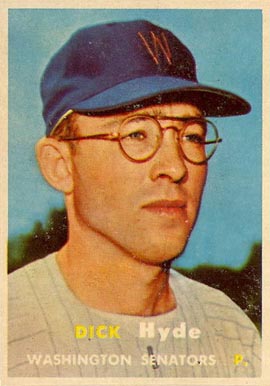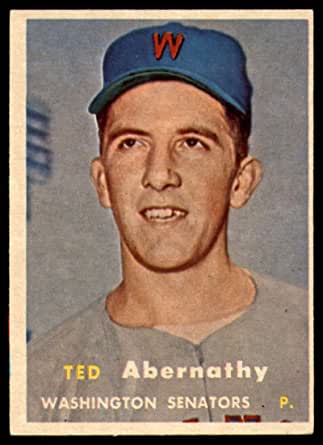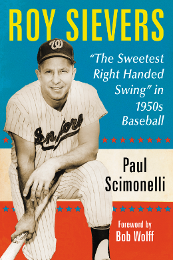By Jeff Stuart
In the 1950s, two of the most interesting Washington Senators, Dick Hyde and Ted Abernethy reintroduced submarine pitching to baseball. They were not the first. Russ Christopher of the Indians threw that way in the early 40’s and before that there were Carl Mays and Elden Auker. Pittsburgh’s Kent Tekulve and Kansas City’s Dan Quisenberry would make it fashionable again a decade later.
But it was definitely unusual and even more so for one team to have two submariners at the same time. Both debuted in April of 1955. Abernathy first pitched in Yankee Stadium in the second game of the season. He gave up a homerun to Mickey Mantle but that was the only run he gave up in two thirds of an inning. Hyde first pitched 10 days later, pitching a scoreless third of an inning.
“Virtually every baseball man rates Abernathy as the potential star of the staff,” wrote Washington Post Columnist Bob Addie in January 1957. “They say he has everything to become a great pitcher.” Abernathy, considerably bigger than the 5’11, 170 pound Hyde, had a longer and more successful career. But they both had their moments in the sun. Hyde’s sidearm motion came naturally,” he “said, “after I hurt my arm pitching in the Army.” Abernathy’s delivery also was the result of injury.” After I hurt my shoulder when I was a sophomore in high school,” said Ted, “I couldn’t throw overhanded anymore. So I started pitching with a low sidearm delivery. Then, in 1959, I had to undergo an operation for back bone chips. When I went back to pitching, I had to throw underhanded.”
Calvin Griffith suggested to Hyde in 1956 that he go completely underhand. It was very good advice. “I was really wild and couldn’t find the plate with a sextant,” he said. He went back to Chattanooga, and discovered he didn’t have the stamina to go a full nine innings. He turned to relief pitching, and started getting people out.
When he returned to the Majors in 1957, he began to get noticed. “Are you sure you’re in the right park, buddy?” one batter asked. Jimmy Piersall of the Red Sox once told him to stop throwing like a girl.
The American League voted Hyde its Sophomore of the Year in 1958, the best year of his career. His 1.75 era was the lowest for a Washington pitcher since Walter Johnson’s 1.49 in 1919. Hyde finished 12th in the voting for Most Valuable Player. “That fellow throws from out of the drain pipes,” said the Yankees Casey Stengel.
He posted 18 saves in 53 appearances and a 10-3 record, beating every club except the Orioles. And he didn’t allow a run in 14 innings against them. Gene Woodling of the Orioles said at the time. “Part of the trouble is we never see pitchers like him. That curve of his comes in to left-hand batters like me and rises. That’s rough.”
“Hyde’s pitches came leaping at the hitters like something out of the grass, complete with hiss,” said sportswriter Shirley Povich.”There are some who will contend he is the finest thing the Nats have going for them. Physically, he looks like a less-than-ordinary guy, not very big and with gold trimmed glasses. But he has right handed hitters backing away from the plate in bewilderment and since he added a screwball he owns the left-handed hitters too. It is quite wondrous to see. The only homerun against him was hit by Joe De Maestri of Kansas City whose homers are somewhat accidental.”
To Hyde, his own sudden success was “somewhat accidental.” “I’m no bonus player,” he said. “Funny, when I started to throw underhand, I could do things with a baseball I never expected. But if I hadn’t flunked German in my first semester at Illinois, I might have taken up medicine.” He enjoyed his new found status though. Halfway through the season, he told catcher Ed Fitzgerald, “I just realized I am beginning to look tough to the hitters.” He would swagger in from the bull pen and non-chalantly toss his warm up jacket to the bat boy. He became one of Griffith’s 3 untouchable pitchers, behind Camilo Pascual and Pedro Ramos. He asked for a $16,000 contract for the 1959 season, but settled for $2000 less. “There is no point in haggling,” he said. I don’t like being a holdout.” But in 1959 his poor start (An ERA of 6.54) led to his being traded to Boston along with Herb Plews. Griffith also traded his 1958 Rookie of the Year, Albie Pearson to Baltimore that year. “I know I let the team down,” Hyde said,” but not for lack of trying. I have had tendonitis and all sorts of problems with my shoulder. I couldn’t extend by arm. So I lost my best pitch. Without that sinking fastball I’m sunk. This submarine pitch is unnatural anyway.” For Hyde the Nats got Billy Consolo, a shortstop the team coveted, and pitcher Murray Wall. Hyde was returned to the Nats by the Sox just 3 days later. Wall returned to Boston. Dick finished the season with 4 saves and a 2-5 record.
On August 31 in Boston he stole a base. “I got a hit off of Billy Monbouquette,” he said. “Then he must have forgotten me on first base and wound up, so I took off and there was no throw.” Thus had one stolen base in one attempt. But Hyde was not a very effective pitcher for the rest of his Major League career. It ended with the Baltimore Orioles, who purchased his contract in 1961.
In 1955, the highly touted Abernathy 55 had a disappointing 5-9 record. “Your trouble,” said manager Dressen, “is that you let batters take too many liberties. You’ve got be tough out there. You’ve got to get mean if you are ever to be a real good pitcher. I’m sending you to Louisville. I want you to stop being a “nice boy’.” “I took it to heart,” said Ted, “I was always scared of hitting the batter because I wasn’t too sure of my control, he told Bob Addie. “Down in Louisville I suddenly stated to get the ball over the place and with control came confidence. With confidence came the ability to brush back a batter once in a while. You know you must prevent a batter from digging in or they knock your brains out. Got to keep them loose. He led the American Association in strikeouts and was named “The Colonel of the Year.” The Yankees expressed an interest in Abernathy. But Griffith told Addie it would cost the Yanks “half their ball club.”
In his rookie year Ted threw two shutouts against the Tigers. After his shutout of the Tigers on Sept 11, the club would not get another until Chuck Stobbs blanked Baltimore on Sept. 5, 1956. “Ted told Shirley Povich in Jan 1958 that he blamed Manager Dressen for his ineffectiveness in 57.”He tried to make a cute pitcher out of me and I’m a fast-baller.” Dressen had predicted a huge future for Abernathy. But he was released by Washington in May 1960 and signed by the Milwaukee Braves. He was purchased by the Cleveland Indians in 1961. But he did not return to the Majors until 1963. He saved 12 games for the Indians while posting a 7-2 record and a 2.88 ERA. In 1964, he fell to 2-6, with a 4.33 ERA, However, still picked up 11 saves. He added a knuckleball in 1964. Indians catcher Dick Bertell, commented, “It’s really something. It is a rising and floating knuckler. I’ve never seen anything like it.” I feel like throwing underhanded gives me a big advantage against hitters to come into the game in the late innings when they’ve been looking at an overhand delivery up till then. I throw four pitches basically, a sinker, a curve that rises, and a flat curve, plus now a knuckleball for a changeup. Because of the way I throw I think I have better luck against left-handed batters than most right-handed pitchers do. I have to pitch pretty often to be effective. Otherwise I tend to be wild.”
He was purchased by the Cubs in 65 and became the league’s most dominant reliever, winning his first “Sporting News Fireman of the Year” award, finishing the season at 4-6 with a 2.57 ERA and a new record for saves with 31. His 84 appearances broke the big-league record of 81 set just the previous year by John Wyatt of the Kansas City. But in 66 the Cubs sent him to Atlanta. Prior to the 1967 season, he was a Rule 5 draft pick by Cincinnati. He would win the FOY honor again in 1967, posting 28 saves with the Reds.
After stints in Atlanta and Cincinnati Ted was traded back to the Cubs in 1969 joining Phil “the Vulture” Regan and Abernathy. They were the NL’s top two relievers in 1968. Along with Hank Aguirre, they formed a solid Bullpen for the Cubs that season. But the “Miracle” Mets were that year’s team of destiny. Abernathy had had a good year (4-3, 3.16 with three saves in 56 games).
In 1970 he appeared in 11 games for the Cubs, chalking up a save. At the end of May, he was traded to St. Louis where appeared in another 11 games, recording a win and a save. Abby liked in in St. Louis. But the Cardinals sent him across the state to Kansas City. “It’s part of Baseball,” said GM Bing Devine, players move around. Nicknamed “Angle Worm” at KC, because his pitches seemed to come out of the ground, Ted went on to lead all AL relievers in Fireman Award points from July 2 through the end of the season. He finished with a record of 9-3, a 2.59 ERA and 12 saves.
Ted pitched two more effective seasons for the Royals. In 1971, he pitched 63 times, going 4-6, 2.56 with 23 saves and finishing third for the AL Fireman award in 1972 (3-4, 1.70 ERA and five saves). The 39-year-old vet ended his major league career on September 30, 1972 against the Oakland A’s. He entered the game during the fifth inning successfully got Reggie Jackson to ground out to first and Dave Duncan to pop out to third.
In November 2011, Tekulve, who saved three saves in the 1979 World Series and holds the National League record for career innings pitched in relief (1,436⅔), told SABR’s Bob Hurte. That Abernathy was a huge influence on his own success. “Ted was who I copied my delivery from after I decided to move away from my natural sidearm delivery. I watched him as a kid when he was with the Reds, he said.”








